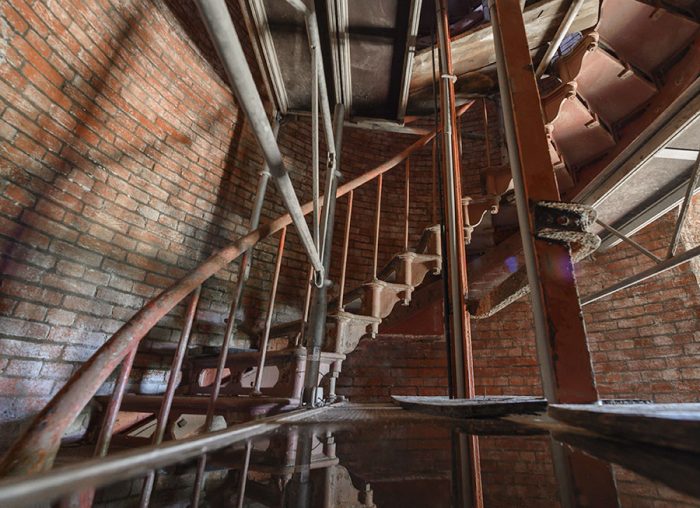
The ongoing Cape Hatteras Lighthouse restoration project reached a milestone this past week. 99.9% of the interior paint removal was completed, (an endeavor that started in the spring of 2021), and multiple tests confirmed that the interior air quality was safe and free of lead-based paint, eliminating the need for the hazmat suits that workers had to wear well into the summer months.

Stripped bare to the exposed red bricks, with just patches of stucco-like material or small pieces of blue painters’ tape remaining, the end of the first phase for the multiple-year project is a landmark moment, but this initial phase has also resulted in new challenges, and new mysteries.
As anyone who has tried to remodel an old coastal home knows, once you start to peel off layers of paint and protective coatings, you start to discover a new arsenal of potential issues under the surface. With this ongoing project serving as the most intricate and meticulous effort to restore the 151-year-old lighthouse, the punch list of items to repair, restore, or replace when the renovations begin has gotten a bit longer in the paint-removal process.
With the paint removed, these little areas of recently-discovered damage are visible if you look hard enough. A continuous and jagged crack runs through 6-7 stories of the lighthouse, which occurred after a lightning strike in 1890. Other spots are completely devoid of the mortar that holds the bricks together, while areas where metal meets the brick interior, (like near the lighthouse’s windows), have small gaps where deteriorated metal used to be.
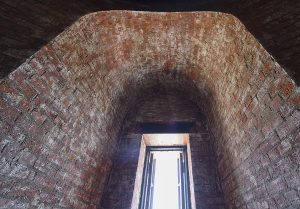
But the project is certainly in good hands. A team of historical architects and engineers, along with personnel from the State Historic Preservation Office and the Cape Hatteras National Seashore, are involved in every step of the project, while outside help from specialist contractors like Quinn Evans Architects or Heritage Contracting are helping to conduct the restoration in the safest and most historically accurate way possible.
“We’re working with the best of the best,” said David Hallac, National Parks of Eastern North Carolina Superintendent.
“The brick is in worse shape than we expected, but it’s nothing that can’t be fixed or stabilized,” said Brian J. Frailey, the National Park Service’s Project Manager for the lighthouse project. “It’s like taking away layers of an onion. All of the layers tell a story.”
Paint removal isn’t typically a labor-intensive venture for most remodeling projects, but at the Cape Hatteras Lighthouse, which has seen layers of brushstrokes over the past century and a half, (with some materials that are now classified as hazardous), the project requires a lot more attention to detail. This is especially true when workers are focused on retaining the integrity of the historical details of the structure, and want to use the least damaging materials possible to safely remove paint from the inside out.
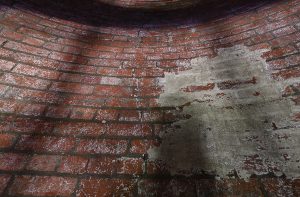
Though it was initially thought that workers would have to peel through roughly five layers of paint, at least seven layers of substances had to be removed to reach the red brick walls, which included some materials that have not yet been identified.
“We discovered a lot of interesting materials that were, at one time, used for repairs,” said Frailey. “We’ve sent these materials off to the lab, to make sure they weren’t [hazardous], and to determine what they are.”
Uncovering all of the materials used in an untold number of previous renovation efforts was one of the paint-removal phase’s discoveries. But the project is also focused on how to preserve the lighthouse in the future, especially when it comes to moisture.
The lighthouse has a double-wall construction. This means that there is an outer wall and an inner wall, and a hollow gap of empty space until the two walls meet, approximately 130 feet in the air. This original design with European roots was fairly revolutionary when the Cape Hatteras Lighthouse was built in 1868-1870, but it also made the lighthouse stronger, and able to withstand storms and a 1999 move to a spot 2,900’ feet inland.
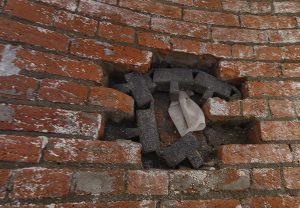
However, this airy gap between the exterior and interior walls may have caused some unintended structural issues as well, which are related to the old layers of paint. Water leaking into the lighthouse can easily get trapped in this empty space, and can cause damage to the brick material. As such, special sensors have been temporarily installed in small grooves of the structure to determine how excess moisture may have damaged the lighthouse, and how it can be addressed in the future.
“We thought that the sensors would show high humidity, because of the paint peeling off,” said Denise Close of Quinn Evan Architects. “We’ve been collecting data for almost a year now… there is so much moisture coming into the structure, and we need to verify that the moisture is getting out.”
When the restoration works begins, the moisture problem will be addressed by using a more breathable coating of paint, which will allow any water to escape naturally. Up until this point, some of the heavier coats of paint and different materials have basically trapped moisture inside, leading to little leaks and puddles throughout the old structure.
The moisture issue stemming from the double-walled nature of the lighthouse is just one example of the unique issues or mysteries that workers found in this first phase of the renovation. While there are broad plans to address a number of big restoration items, which range from the marble surfaces in the interior to the light at the top of the 198-foot tall tower, stripping away layers of materials and starting from scratch is a solid way to have a better appreciation of the exact work involved in the future.
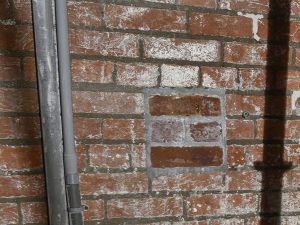
“The paint removal exposed a lot of these issues, and this allows us to get ahead of the game,” said Hallac. “It’s foreshadowing for the next phase of the project – expect the unexpected. We will have to be flexible, patient, [and ready] for what comes next.”
As the patchwork of old paint and unusual bonding materials have proven, this is certainly not the first time that the lighthouse has undergone a renovation, but it is the first time that attention to detail is front and center.
“There has never been such a precise study of this national monument,” said John M. Havel, Cape Hatteras Lighthouse Researcher and Board Member of the Outer Banks Lighthouse Society. “In [previous projects], they would just sandblast and get all the paint off before applying again…. This project entails the discovery of the story behind all this work.”
In fact, there have been innumerable repairs to the lighthouse in years past, including a months-long project in 1976 when all of the exterior and interior paint was casually removed before a new coating was added. Unlike now, the goal at that time was to simply get the job done – with no attention paid to the stories that previous paint layers may have exposed.
Local resident and photographer Don Bowers was on a three-man crew during this 1976 project, and he landed the role of tackling the paint removal and application at the top of the lighthouse, because his crew members were afraid of heights. When he was hired, the Virginia-based contracting company had a hard time keeping out-of-town workers at the Buxton site for more than a week, because at the time, Hatteras Island didn’t have any “bars, alcohol, or women,” according to Bowers.

“The biggest mistake I made, because I was taking pictures at the time, was that I didn’t take a single photo of what we did, and what we were working on,” said Bowers, who also covered the 1999 lighthouse move, and is currently covering the restoration. “I did write my name on the lightning rod at the very top, because I figured no one would ever see it.”
This is just one of the stories that have been unearthed in this first wave of the restoration project, and it likely won’t be the last.
“John [Havel] has done extensive research which has helped us tremendously, and we also have people like Don [Bowers], who are really helpful when it comes to filling in the blanks,” said Hallac.
As a result of this multiple-pronged approach to historic restoration – combining historic research and lab testing with anecdotal stories – it’s likely that the Cape Hatteras Lighthouse will end up with a more complete history than it has ever had before.
However, there is still lots of work left to do, and stripping the lighthouse down to its bare-bones interior is just the first step.
Soon, the environmental review process will begin, and the public will be invited to comment on the different alternatives for the project’s way forward. Options will vary widely, and will include a long list of particulars, such as whether to repair or replace the light, or whether to include a landscaping project for the dusty-colored lighthouse grounds.
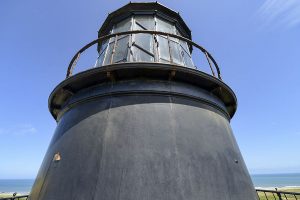
More information on the first public meeting for this part of the process will be coming in the next few weeks, and once this stage is complete, contractors can get to work on the trickier, and lengthier, renovation aspects of the project.
Just like any old-structure renovation, data is still being acquired to determine the exact scope of the work ahead. For example, that 1890 lightning strike crack may need some in-depth work if it compromises the structural integrity of the lighthouse, but it also might not. Structural engineers and additional specialists will answer these questions before the big restoration work beings, likely in the late summer or early fall of 2022.
In terms of budget for the ongoing restoration work, the project has been in the works for years, and the National Park Service has already received funding for the upcoming repairs. The items that need to be addressed originally stemmed from the results of a 2014 Comprehensive Condition Assessment Report and a 2016 Historic Structure Report.
The complete restoration project is estimated to take a total of 1-3 years, but it all depends on what other surprises are unearthed.
“We have a lot of info [from our testing] coming in, so we’ll know more in the next week or so,” said Frailey.
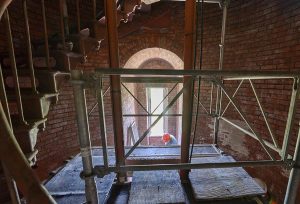
“All this stucco-like material that remains, we still have a lot of mysteries there – ‘Does it need to be removed? Can it stay?’ And there are a lot of questions like that,” said Hallac. “But we’re excited to be uncovering so many questions.”
The lighthouse may open for a limited climbing season later in the summer or early fall, once the contractors have demobilized and have transformed the current construction site to the old familiar landmark. Right now, large squares of scaffolding have been erected on virtually every level of the lighthouse, and all of this equipment needs to be removed in order to make the lighthouse a safe place to visit. “If it’s possible [to open the lighthouse to the public], we will make it happen,” said Hallac.
In the meantime, the public can rest assured that when the lighthouse does reopen, it will be at its historically-accurate best, with newfound chapters of the lighthouse’s history.
“The interior is an anthology of how [all of these issues] have been addressed in the past,” said Frailey. “So it’s a discovery of the lighthouse’s story.”

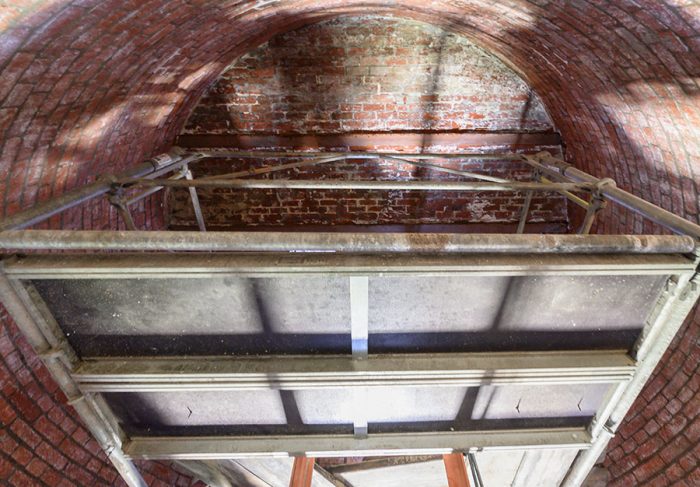



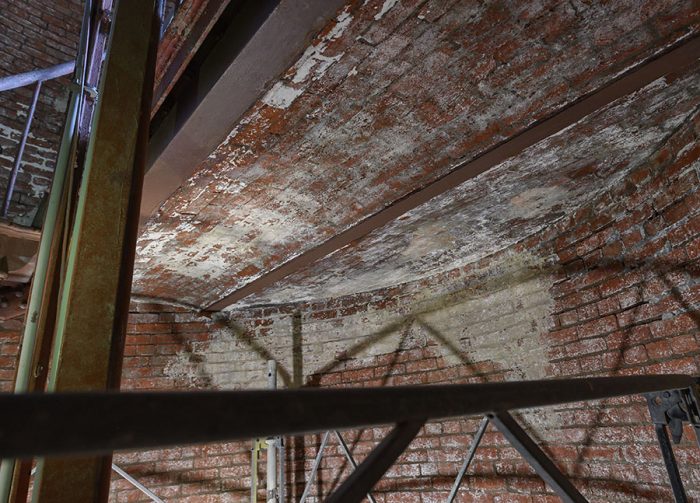




Can they leave the bricks exposed or paint an clear finish on them? They look great in their natural color…..
david r strickland — I agree that the bricks look very nice in their natural color and state, but the project is very specific to try to “restore” the lighthouse to what it looked like in its early years (specifically ~1873-~1913). Since the first days of its completion the interior had been painted white–I would have to go back and locate the period documents from the time, which I do have, but it was something like a “lime-wash” or a “cement-wash” coating. Therefore the historians and preservationists are looking to mimic that, but with a breathable modern alternative that will allow moisture to move back and forth through the brick.
Although I was born and raised in North Carolina, starting with Pasquotank County, I had climbed the Cape Hatteras Lighthouse many times as a child – in 1999 I wanted to be there after they moved it – and I was in 1999 and I did climb all those steps then – my husband and grand-daughter stayed below – because SHE was scared to climb – so I waved to them from way up there!!!! So thankful I got to do that then ’cause now I would only be able to stand and stare at it!!